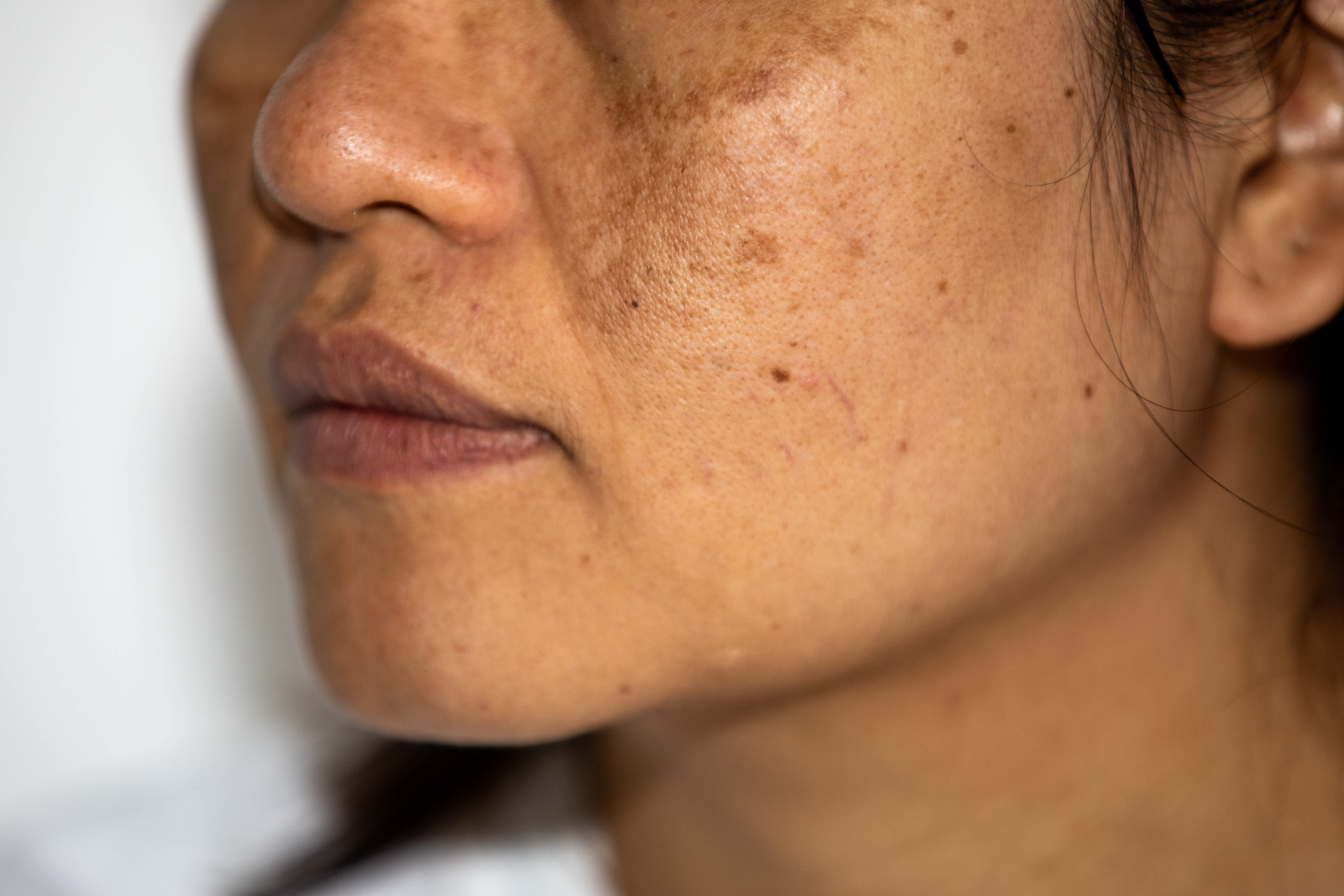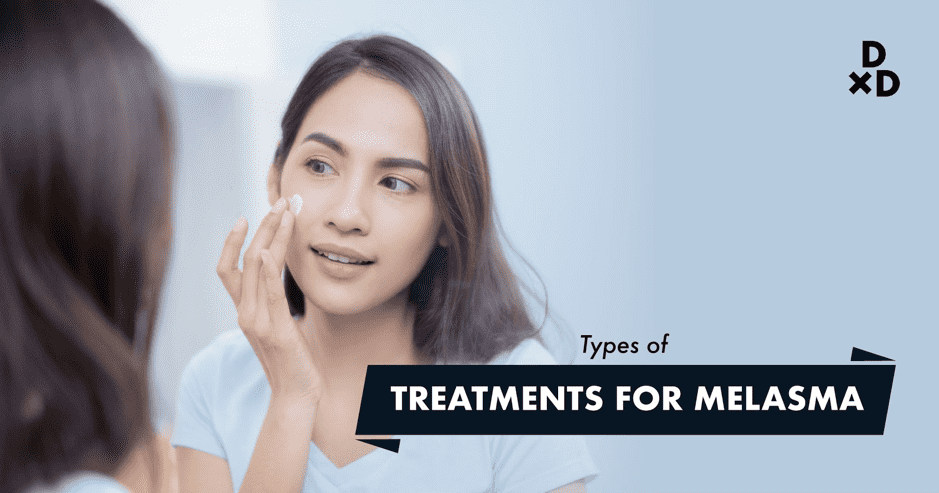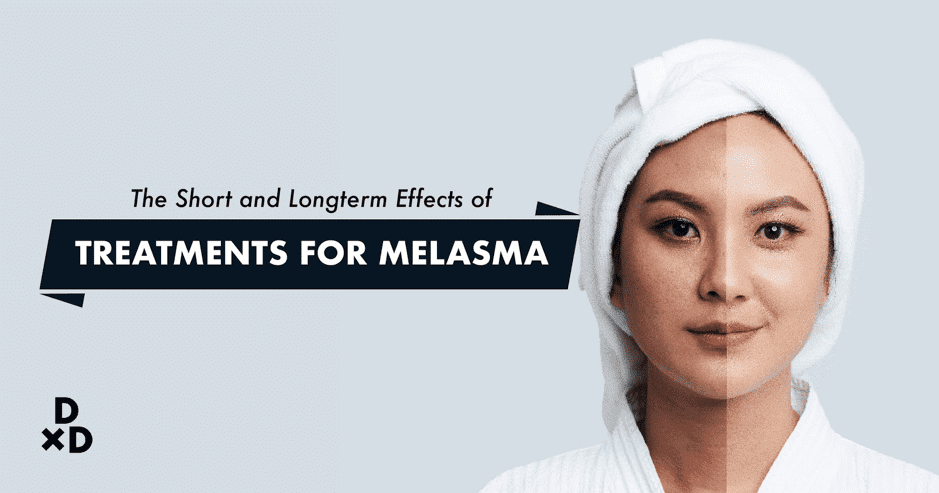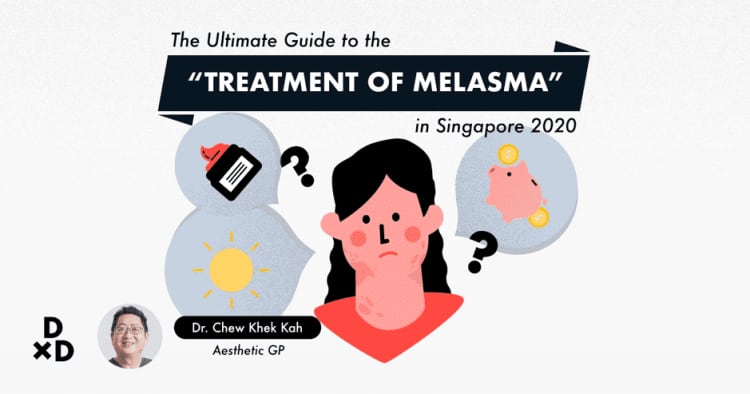You may be wondering what causes you to develop strange brown marks on your face and whether they can affect your overall health. My experience as an aesthetic doctor for more than 10 years allows me to share about Melasma Treatment in Singapore, the solution to your brown marks.
What is melasma?
Melasma is a common skin pigmentation condition that appears as a brown to grey patches typically on the cheeks, forehead, nose and chin.
It occurs predominantly in females with only 10% of males having this condition. Melasma, also known as chloasma, is common in females after pregnancy, giving rise to the term “mask of pregnancy”.

The causes are multifactorial and include sun damage, hormonal factors, inflammatory (increased mast cell activity), increased vascularity and disruption of the basement membrane and skin barrier function.
Treatment nowadays is multimodal and include laser toning, lasers to reduce vascularity, reducing inflammation, and restoring basement membrane integrity. Of course, sun protection and topical lightening agents and moisturiser are required.
Read on to find out more about Pigmentation Lasers in Singapore.
Can Vitamin D deficiency cause Melasma in Singapore?
Currently, there are no conclusive results as to whether vitamin D deficiency causes Melasma. There are many factors that can contribute to the development of melasma, which make it a complex condition [1]. Known factors include:
- Pregnancy,
- Hormonal drugs (contraceptive pill),
- Hormone therapy,
- Some targeted drugs for cancer,
- Scented soap or deodorants.
The factors mentioned above contribute to the excessive production of melanin. To some people, they can also inherit melasma from their parents.
What is the difference between Melasma and Hyperpigmentation?
Human skin colour ranges in variety from darkest brown/ black (skin type 5) to the lightest hues (skin type 1). This is the result of genetics, which is the product of the individual’s biological parents’ genetic makeup, and sun exposure.
The cells responsible for pigment production are referred to as ‘melanocytes’ and when they are stimulated, as in sun exposure, or damaged or unhealthy, they can produce an excess of melanin leading to hyperpigmentation.
Hyperpigmentation can take the form of small discrete freckles to the larger solar lentigo to large areas of patchy pigmentation.
In cases where the melanocytes are no longer active and capable of melanin production, a condition called ‘hypopigmentation’ ensues.
How often do patients with melasma get misdiagnosed with hyperpigmentation?
Misdiagnosis of melasma with hyperpigmentation can occur, but, in my experience, this does not happen often. If the history taken during the consultation is thorough, and the doctor is sufficiently experienced to recognise the pattern of pigmentation that is typical of melasma, then a correct diagnosis is often given.
What are the melasma treatments available?

1. Topical creams
Topical creams can be used if your melasma is not too severe. However, you need to use sunscreen as well in order for the creams to work properly and prevent the melasma from recurring.
Some of the topical treatments available are: [2]
- Hydroquinone,
- Azelaic acid,
- Kojic acid,
- Retinoids,
- Topical steroids.
2. Oral medications and supplements
You can usually get oral medications prescribed to you from your doctor. Your doctor will often prescribe oral medication alongside other treatments. One medication that is generally prescribed is Tranexamic acid, which reduces skin pigmentation and redness [3].
3. Medical procedures
If your case of melasma is severe that topical medications do not work, your doctor will usually advise you to go for medical procedures. These are some different types of medical procedure, such as:
Microdermabrasion: This is a procedure that removes the thick and uneven outer layer of your skin. There is no down time for this procedure, and your doctor usually prescribes you with a moisturiser or skincare products to prolong the result. [4]
Chemical peel: This is a procedure that removes the outer layer of your skin by applying a chemical solution to your face. Within a few days, your facial skin will shed and grow a new layer of skin that is smoother and more even.
There are 3 types of chemical peels, light, medium, and deep chemical peels [5]. While patients who have lighter skin can go for medium and deep chemical peels, you are advised to go for a light peel if you have darker skin.
Read on the safer ways to treat Melasma for darker complexions.
Medical Grade infusion of Vitamin C and or other whitening agents: This infusion will be done via one of iontophoresis, electrophoresis, or plasmaphoresis. Some clinics will also use devices like SilkPeel Dermalinfusion or HydraFacial to deliver these whitening agents.
Laser treatment: there are 3 types of laser treatments that people mainly go for.
Thulium laser: This category of laser utilises a 1927nm wavelength and includes the Korean BB laser, the Lutronic Lasemed, as well as the Clear & Brilliant Laser.
This is a laser procedure to treat pores and pigments by renewing damaged skin and stimulating the production of collagen. Depending on the laser strength, the downtime can vary from 0 to 7 days [6]. Results can be seen after 2 to 3 weeks.
Q-Switch laser: This is a laser treatment that treats ageing and pigmentation issues, including melasma, with little downtime. The laser energy breaks down the pigment into smaller pigments and is naturally cleared away by the body [7]. Results can be seen within 3 to 4 weeks after treatment.
Pico Laser: This is a laser treatment that has many benefits, one of which is that it removes pigmentation in a non-ablative way. The difference between the Pico laser and Q-switch laser is that the pulse duration is much shorter than Q-switch.
This means the risk of getting a hyperpigmentation from the laser is relatively smaller [8]. The best results are achieved after 4 to 6 treatment sessions.
Vascular Lasers: This category of lasers are useful in reducing the increased vascularity and increased VEGF activity in Melasma. In my practice the preferred choices are the Dual Yellow Laser and the Excel V laser.
How is the patient journey of a melasma treatment like in Singapore?

The initial consultation is most important as a correct diagnosis of melasma needs to be made. A detailed history taking is necessary as it will reveal the recurrent relapsing nature of melasma.
The typical distribution pattern of Melasma needs to be recognised, and this in part will be dependent on the experience of your doctor.
What are the short/long term side effects from melasma treatment?

1. Topicals
The previous gold standard was hydroquinone 4% or Kligman formula . Most doctors are now using cysteamine cream because of the long term side effects of hydroquinone and especially the potential of carcinogenicity. It reduces pigment marks, brown spots, produces a uniform and light skin complexion, and can be used on any skin type.
Cysteamine cream works by reducing melanin in the skin. It is also an antioxidant and can protect against ionizing radiation. Cysteamine is found naturally in the body, especially in human milk. Finally, it is anticarcinogenic, meaning it reduces your risk of cancer, and antimutagenic.
2. Orals
Oral medication is typically in the form of tranexamic acid and oral sunblocks like crystal tomato, heliocare pure white radiance or a combination of vitamin C and glutathione.
Tranexamic acid gives results even in low doses (500mg daily) over short periods of time (8-12 weeks). They do not have much side effects associated with them and are a good therapeutic option when hydroquinone 4% or cysteamine cream is ineffective. Studies show that Transexamic acid does not increase thromboembolic risk, which is the risk of a blood clot dislodging itself and clogging up another blood vessel. However, make sure you let your doctor know what health conditions you have in case of contraindications.
3. Light-based and Energy Devices
These treatments include IPL, the various forms of pigment and vascular lasers. The globally known Q-switched laser toning has now been replaced by the newer Picosecond lasers, of which the notable ones would be Picosure, Picoway, PicoGenesis, Discovery Pico, and a host of other Korean made Pico lasers.
The main advantage of these pico lasers is their ability to break down the pigment onto much smaller particles, which makes it easier for the body to eliminate them. At the same time, the Picosecond technology means there is less collateral thermal damage to surrounding skin which means less risk of hyperpigmentation.
4. Various vascular lasers
Vascular lasers are now used to treat melasma. Researchers have identified increased vascularity in melasma due to increased activity of vascular endothelial growth factor, a signal protein produced by cells that stimulate the formation of blood vessels (VEGF). In my practice, I would choose either the Dual Yellow Laser or the Excel V laser based on the patient skin type as well as the sensitivity of their skin.
5. Slyfirm
Slyfirm is a unique bipolar non-insulated pulsed RF that has been shown to be effective in the treatment of melasma mainly due to its ability to strengthen the basement membrane as well as reducing the activity of VEGF. It also has an effect of stimulating the fibroblasts resulting in increased production of procollagen 1, which is known to minimise melanogenic factors.
Are there any downtimes for laser treatment of melasma?
Thulium laser
Some common scabbing may occur after the treatment, which will disappear after 2-4 days.
Q-switch laser
You can continue your regular activity after this treatment. Expect skin redness that usually fades within an hour. Hives also may occur, but it can be treated using medication.
Pico Laser
There is almost no downtime for this procedure. If you choose to do pico laser treatment, you have to make sure that you avoid prolonged sun exposure for a week after the treatment to prevent hyperpigmentation from occurring.
It is usual for certain patients to experience discolouration on the existing pigmentation before it starts to wear off.
Just how effective is laser treatment for melasma? Read this answer to find out more.
How much does melasma treatment cost?
Treatment
Price estimation
Thulium laser
± $400-$600 per session
Q-switch
± $250-$400 per session
Pico laser
± $250-$1000 per session
Vascular laser
± $400-$600 per session
Slyfirm laser
± $400-$500 per session
What are some lifestyle habits we can adopt to prevent getting melasma?
I understand that having melasma can ruin some people’s confidence. While it is a little complicated to treat, there are several things that you can do to minimise the risk of developing melasma:
1. Wear sunscreen daily
Sunscreen plays a vital role in preventing melasma since a significant cause of melasma is sunlight. Use sunscreens that protect you from both UVA and UVB with SPF 30 or higher.
2. Wear hats
Do not forget to wear a hat when you are outside to avoid direct sunlight as it can cause hyperpigmentation and trigger melasma.
3. Use gentle skincare
Harsh skincare can cause irritation and trigger melasma. Use products that will not give you a sting or burn sensation, especially if you have sensitive skin.
Conclusion
Melasma is not harmful and is generally treatable. There are also things that you can do to prevent melasma from developing on your skin, with various treatments that you can choose to treat melasma.
Before attempting to treat your melasma, make sure that you consult your doctor to know which treatments to do according to your medical history and skin condition.
Also Read: What is the difference between an aesthetic doctor and a dermatologist?
I understand that treating melasma requires a lot of time and effort because it won't go away from just a single treatment. Please take a note that you will be able to achieve the best result if you are consistent with the treatment.
Interested to learn more about Aesthetic Clinics in Singapore? Read on to learn more.
Dr KK Chew is the Founder and Medical Director of NU•U Aesthetics & Wellness Clinic located at Paragon since 2004. He is also the past Vice President of the Singapore Society of Aesthetic Medicine and currently serves as its Honorary Advisor. He is the key opinion leader for various aesthetic companies, including lasers and body contouring devices.





